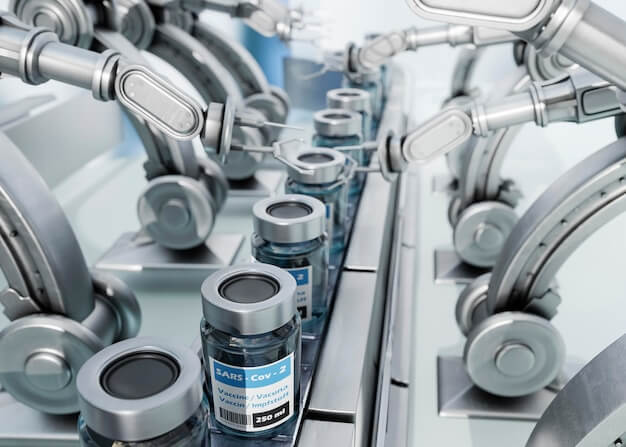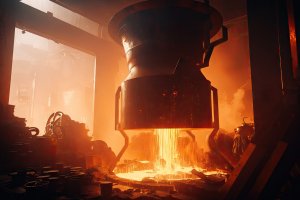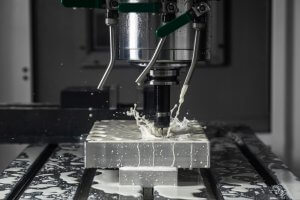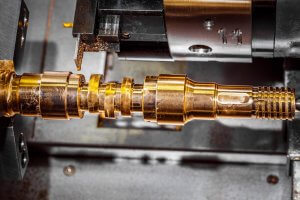Introduction to 5-Axis CNC Machining and its Role in Manufacturing Industry
The revolutionary technique of Five-axis Computer Numeric Control machining, or simply 5-axis CNC machining, plays an integral role within the manufacturing industry. Its superior precision and vast adaptability enable manufacturers to sculpt intricate components out of a multitude of materials efficiently. While it is versatile enough to work with a wide array of substances, this paragraph puts forward a spotlight on one such vital material — Titanium. Incidentally, Titanium’s robustness combined with light weight, corrosion resistance characteristics makes it highly sought after in sectors like aerospace, military equipment, automotive parts etc. Through 5-axis CNC machines, complex geometrical titanium productions are made possible.
China Online CNC Machining Service
Understanding the Basics of 5-Axis CNC Machining
The 5-axis CNC machining is a system with five distinct axes which move in different directions at the same time. These axes are often labelled as X, Y, Z (three linear axes) plus A and B (two rotational axes). To visualize its operation, think of your hand: three fingers moving up-and-down, left-to-right, or forward-backward; while your wrist rotates side to side or flips back and forth, similar to our major joints’ capabilities. In terms of function:
- X, Y & Z – Linear Axes: They represent movement along three perpendicular lines that meet at a point, much like making straight lines on paper top-to-bottom (X), left-to-right (Y), and thrusting forward or pulling backward (Z).
- A & B – Rotational Axes: Imagine an object rolling over clockwise or anti-clockwise. That’s how the rotational axes work to maneuver around part complexities.
To illustrate how this translates into action, imagine carving out a sculpture from a block of titanium simultaneously using five chisels positioned differently. The integrated motion capability of all these axes contributes to improved production efficiency, reduction of setup time and cost savings by eliminating multiple setups.
The Importance of Titanium in Manufacturing
Titanium, with its unique set of properties, has become an increasingly significant material for industries across the globe. Its novel combination of high mechanical strength and low weight makes it a prominent choice for manufacturers in several sectors.
- Durability: Titanium offers exceptional durability that can resist wear and tear from heavy industrial use over time. It retains its functionality, even under intense conditions.
- Strength: Despite being lightweight, titanium possesses incredible strength akin to many alloys commonly used in industry, further contributing to its preference by manufacturers.
- Corrosion resistance: Another important property is its remarkable corrosion resistance against seawater, rust, and most mineral acids creating long-lasting components.
The aerospace sector, for instance, uses it extensively because these characteristics make aircraft lighter, more resilient, and durable. Even within the medical field, the strength and durability of titanium are utilized for making implants and prosthetics. In short, the structural properties and application versatility solidify the role of titanium as an essential element in manufacturing.
5-Axis CNC Machining of Titanium: Process Overview
5-axis CNC machining of titanium offers several advantages, including:
- Increased accuracy and precision
- Efficiency and reliability
- Ability to machine complex shapes
- High cutting speed and smooth surface finish
Evaluating Cost Factors of 5-Axis CNC Machining Titanium
In evaluating the cost factors associated with 5-axis CNC machining for titanium, several key components come into play. These include machine setup costs, operation time, along with raw material expenditure.
- Machine setup: The setup cost consists of both fixed and variable elements such as initial purchasing price, maintenance, electricity charges, periodic retooling and requires significant investment.
- Operation time: Being a labour intensive process, operation length significantly contributes to the final production cost. As high precision is needed in manipulating titanium parts, machining hours increase thus escalating costs.
- Material-cost: Given that titanium is rarer than other machining materials like aluminium or steel, raw material pricing plays a sizeable role in overall project budget. It often necessitates careful inventory management and efficient usage patterns to control expenses.
To illustrate, let’s consider a simplified calculation. Suppose the set-up cost is $5000, machine operational timing charges are $50 per hour assuming total operating hours are 100. Then, let’s take into account an estimated $4000 worth of titanium used within the same period. Upon aggregating these figures ($5000+$5000+$4000), the total production cost amounts up to $14,000. This exemplifies how each component has a direct impact on the overall production cost when using 5-Axis CNC machines to work with titanium.
Analyzing Production Efficiency of 5-axis CNC Machining for Titanium
In the context of 5-Axis Computer Numerical Control (CNC) machining, production efficiency is gauged by how well a machine can execute complex titanium component manufacturing within minimal time and cost. It takes into consideration factors such as speed, accuracy, waste reduction, operator engagement, and resource management.
- Speed: Faster processing times translates to higher output.
- Accuracy: High precision minimizes material wastage due to errors and reworks.
- Waste reduction: Proper tool paths utilize resources efficiently reducing scrap.
- Operator Engagement: Operator knowledge on proper utilization improves production quality.
- Resource Management: Efficient use and allocation of resources impact overall productivity.
A practical case in point being an aerospace company that recently optimized its 5-Axis CNC system to achieve high-speed milling for intricate titanium parts. With enhanced equipment calibration coupled with adaptive software tools, the firm managed multi-sided machining without any part movement or additional setups – slashing their machining time down from two hours to just thirty minutes. This underscores the direct relation between production efficiency in 5-Axis CNC machining and superior output timing.
Advantages and Limitations of Using 5-Axis CNC Machining for Titanium
The use of 5-axis CNC machining in the production of titanium materials offers a distinct set of advantages, as well as some limitations. On one hand, employing this technology results in improved accuracy and reduced wastage. Pieces produced via this method are incredibly precise due to the machine’s complex, rotating cutting mechanisms. This means there is typically less material waste, making the process more cost-effective overall.
- Improved Accuracy: The complexity of the 5-Axis CNC mechanisms can exactly replicate designs with high precision.
- Less Waste: Due to its intrinsic precision, minimal resources are squandered which reduces costs and fosters sustainability.
On the other hand however, programming a 5-axis CNC machine requires advanced technical expertise and is often quite complicated. The intricacy of controlling and coordinating five separate movements simultaneously poses challenges, particularly when creating intricate forms or shapes in titanium.
- Complex Programming: Manipulating five different axes demands higher levels of computational competence and understanding.
In summary, while the benefits of using 5-axis CNC machining for titanium revolve around remarkable accuracy and efficiency, the key limitation lies in the level of technical knowledge needed to operate such an advanced system.
Mastering the Use of 5-Axis CNC Machining on Titanium
In conclusion, mastering the use of 5-axis CNC machining on titanium presents considerable benefits. From optimizing production processes to reducing waste and enhancing precision levels, this advanced technology offers a smart investment for manufacturers seeking to scale their operations and improve cost efficiency. Importantly:
- The utilization of 5-axis CNC machining allows versatile manipulation of titanium – a material popularly used in critical industries due to its strength and resistance characteristics.
- Improved accuracy cuts back defective output thus minimizing wastage, consequently trimming down operational costs in the long run.
- This superior technology mitigates unnecessary manual labor hence increasing overall productivity).
Given these tangible gains, manufacturers are strongly encouraged to consider training personnel and investing in 5-axis CNC machines as a strategic move towards sustainable adoption and utilization of high-tech production methodologies.
Understanding 5-Axis CNC Machining: Cost and Production Efficiency
In the world of metal processing, one might encounter various complex terms like ‘5-axis’ and ‘CNC machining’. Breaking it down in simple language, a 5-axis machine is equipment that can move a tool or a part in five different ways
simultaneously. This results in intricate shapes being machined quickly with high precision. On the other hand, CNC machining, also known as Computer Numerical Control machining, involves using computers to control machine tools.
- The primary function of a 5-axis machine is to increase efficiency and reduce expenses by minimizing the setup time in creating complex shapes.
- Cost becomes a significant factor while calculating its efficiency; hence understanding the cost aspect is crucial for large-scale manufacturing processes where the usage of these machines is prevalent. The benefits of reduced labor time and increased accuracy invariably offset the initial higher investment.
By clearly comprehending these concepts, users will be better equipped to evaluate whether implementing this technology would be beneficial for their specific needs.
Related Posts
- Impeller five-axis CNC precision machining technology
The impeller is the most important part on the rotor, and is generally composed of a wheel disc, a wheel cover and a blade. An integral impeller is an impeller…
- Bronze Rivet Technology in CNC Machining
Bronze type that can process Rivet Phosphor Bronze Characteristics: High strength, excellent wear resistance, good elasticity. Applications: Springs, bearings, and parts requiring high wear resistance and elasticity. Tin Bronze Characteristics:…
- Precision CNC Machining for High-End Audio Equipment
Precision CNC Machining in High-End Audio Equipment Manufacturing Precision Computer Numerical Control (CNC) machining refers to a highly-advanced technology where computer-generated codes are used to operate factory machinery and tools.…
- CNC Machining for Aerospace: Titanium Alloys vs. Aluminum - Performance and Cost Analysis
CNC Machining in the Aerospace Industry: An Introduction and Importance of Material Selection CNC (Computer Numerical Control) machining is a manufacturing process where pre-programmed computer software directs the movement of…
- Exploring CNC Machining: From Titanium to Snap Fit( cnc cutting tools Richard)
Central to the manufacturing industry, Computer Numerical Control (CNC) machining uses pre-programmed computer software to control machinery and tools. By understanding the scope of materials utilized in CNC machines like…
- PEEK vs. PEI in CNC Machining: Which Offers Better Performance for Engineering Applications?
Introduction to CNC Machining and the Materials PEEK and PEI CNC machining is an automated manufacturing technology that involves computer controls directing machinery in performing material cutting operations to produce…








